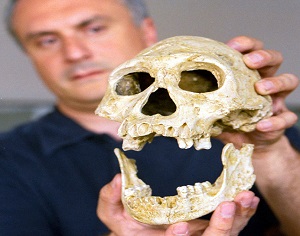Image: David Lordkipanidze of the Georgian Academy of Sciences shows a 1.75-million-year-old skull and jawbone excavated near the town of Dmanisi, some 85 kms south west of Tbilisi, Georgia, in this July 8, 2002 file photo. REUTERS/David Mdzinarishvili/Files
![]()
By Will Dunham
WASHINGTON (Reuters) – A study in which people chewed on pieces of raw goat meat and vegetables smacked with a rock is shedding light on how changes long ago in the way our ancestors dined paved the way for physiological advances that helped make us who were are today.
Scientists said on Wednesday the advent of meat-eating combined with the use of simple tone tools to make food easier to consume meant that members of the human lineage about 2.5 million years ago all of a sudden had less need for chewing.
Without needing to spend much of the day chewing food as chimpanzees do, our ancestors underwent significant evolutionary changes, acquiring smaller teeth, jaws and chewing muscles while losing the snout possessed by their predecessors.
“Shortening the snout might have been beneficial for producing articulate speech, for having a more balanced head, especially useful when running, or perhaps for other reasons,” Harvard University evolutionary anthropologist Daniel Lieberman said.
The changes also may have enabled the development of larger brains in early human species like Homo erectus compared to earlier members of the human lineage like Australopithecus, who combined ape-like and human-like traits.
Meat compared to plants added a calorically dense food to the diet of these early humans as their brains and bodies got bigger.
The researchers conducted experiments measuring how much chewing effort was expended in eating the type of diet our ancestors are thought to have had. Cooking was not commonplace until roughly 500,000 years ago.
Study volunteers chewed on tough raw goat meat, selected to mimic wild game, and three root vegetables: beets, carrots and yams. Electrodes were placed on their faces to measure chewing activity.
Harvard evolutionary anthropologist Katherine Zink, the study’s lead author, said the amount of chewing declined markedly when the food was processed with the type of basic stone tools used at the time: slicing the meat into smaller pieces and pounding the vegetables six times.
The number of chews dropped by 17 percent and the chewing force by 20 percent while the volunteers were able to swallow meat bits that were about 41 percent smaller and thus more digestible.
Lieberman served as a test subject before the volunteers stepped in.
“I can’tell you that eating raw goat is not pleasant. It’s a little on the gross side,” Lieberman said. “It’s really amazingly like chewing gum.”
Lieberman said unlike carnivores, whose teeth are tailor-made for slicing meat, human teeth are “really designed like mortars and pestles, for crushing.”
The research was published in the journal Nature.
(Reporting by Will Dunham; Editing by Sandra Maler)
Copyright 2015 Thomson Reuters. Click for Restrictions.
Mastication-Adaptation-Easier-Chewing-Benefited-Human-Ancestors-media.jpg


